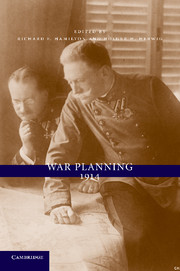Book contents
- Frontmatter
- Contents
- List of Maps
- Contributors
- Acknowledgments
- 1 War Planning: Obvious Needs, Not So Obvious Solutions
- 2 Austria-Hungary
- 3 German War Plans
- 4 War Planning and Initial Operations in the Russian Context
- 5 France
- 6 Great Britain
- 7 Italy
- 8 Conclusions
- Appendix: Suggested Reading
- Index
- References
2 - Austria-Hungary
Published online by Cambridge University Press: 27 January 2010
- Frontmatter
- Contents
- List of Maps
- Contributors
- Acknowledgments
- 1 War Planning: Obvious Needs, Not So Obvious Solutions
- 2 Austria-Hungary
- 3 German War Plans
- 4 War Planning and Initial Operations in the Russian Context
- 5 France
- 6 Great Britain
- 7 Italy
- 8 Conclusions
- Appendix: Suggested Reading
- Index
- References
Summary
In 1914, the Habsburg Monarchy had to face the most difficult strategic situation of any of the Great Powers. Home to people who spoke eleven different officially recognized languages and without an ethnic group dominating state and culture as Russians and Turks did in the tsar's and the sultan's empires, Austria-Hungary was unique. The Monarchy suffered from ethnic conflicts and was almost surrounded by potential foes. In terms of military power, Russia, competing with Austria-Hungary for influence on the Balkan Peninsula, was the most dangerous of them. Since the regicide of King Alexander Obrenovich in 1903, Serbia also challenged the Habsburg Monarchy's supremacy in the area. The Serbian army did not look very menacing to Austria-Hungary's forces until 1912–13 when the Serbs proved to be superior in fighting power to Ottoman and Bulgarian troops. Moreover, mounting unrest among the Serbian population in Bosnia and the southern parts of Hungary fostered fears of an uprising in case of a war between the Habsburg Monarchy and Serbia or Montenegro, another South-Slav neighbor. Tiny Montenegro under King Nikola Petrovich Njegosh tried to expand its influence and forged dynastic ties with Russia and Italy.
Italian nation-building in the nineteenth century had come at the expense of Austria, but there were still some territories with an Italian majority under Habsburg rule. Italy, like Germany, was Austria-Hungary's partner in the Triple Alliance, but relations were usually strained.
- Type
- Chapter
- Information
- War Planning 1914 , pp. 24 - 47Publisher: Cambridge University PressPrint publication year: 2009
References
- 3
- Cited by

